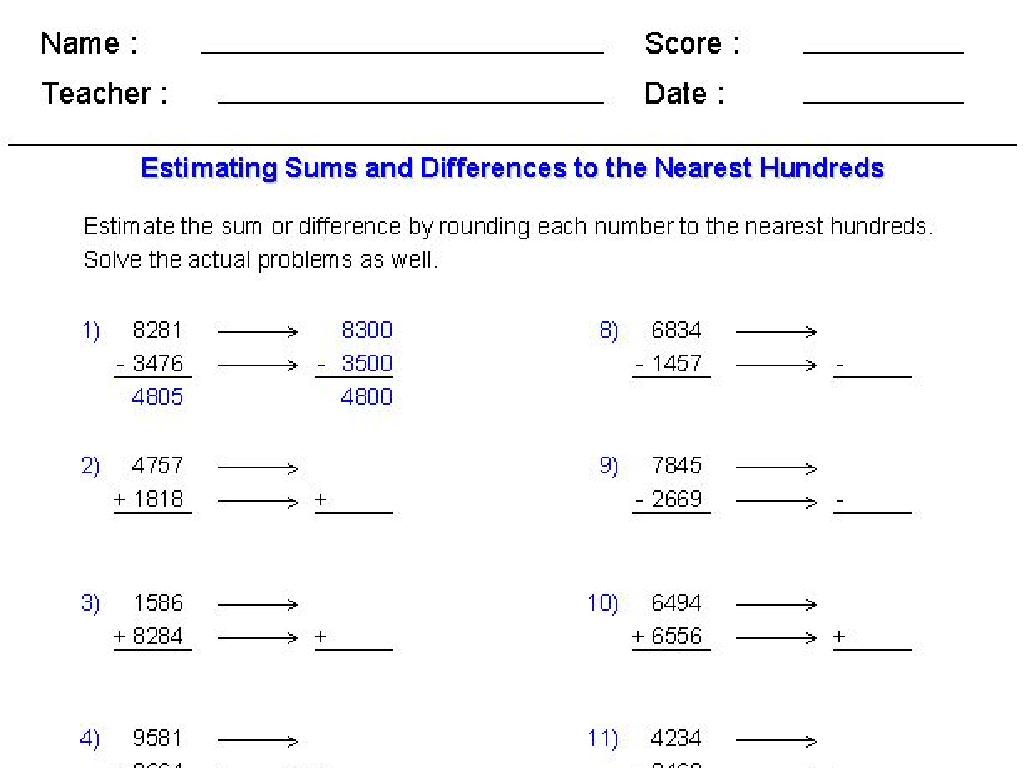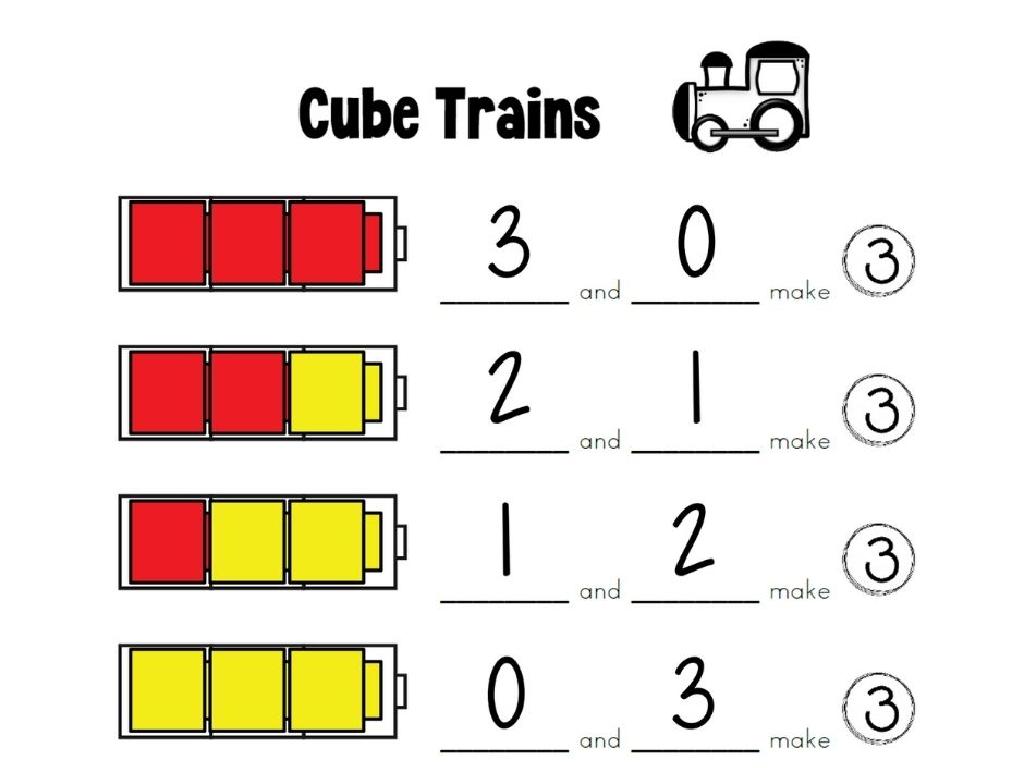Add And Subtract Decimals
Subject: Math
Grade: Seventh grade
Topic: Operations With Decimals
Please LOG IN to download the presentation. Access is available to registered users only.
View More Content
Adding and Subtracting Decimals
– Grasping the concept of decimals
– Decimals represent fractions of a whole
– Steps for adding decimals
– Align decimal points, then add like whole numbers
– Steps for subtracting decimals
– Align decimal points, then subtract like whole numbers
– Decimals in daily life
– Used in money, measurements, and statistics
|
Begin with a review of what decimals are and how they represent parts of a whole, which is crucial for understanding their operations. When adding or subtracting decimals, the most important step is to line up the decimal points to ensure accuracy. Provide examples such as adding money or subtracting weights to illustrate the process. Emphasize the importance of decimal operations in everyday life, such as financial transactions, cooking measurements, and understanding statistical data. Encourage students to practice with real-life examples to solidify their understanding.
Understanding Decimals
– Review: What are decimals?
– Decimals represent fractions of a whole, like 0.5 is half.
– Decimals in daily life
– Used in money, measurements, and statistics.
– Place value significance
– Each decimal place has a value ten times smaller than the one before it.
– Adding and subtracting decimals
– Line up the decimal points and use place value to solve.
|
Begin with a quick review of what decimals are and how they represent parts of a whole, which will help students recall prior knowledge. Highlight the prevalence of decimals in everyday life, such as in currency, cooking measurements, and sports statistics, to show practical applications. Emphasize the importance of understanding place value, as it is crucial when performing operations with decimals. When adding or subtracting decimals, remind students to align the decimal points vertically to ensure each place value lines up correctly. This will prevent common mistakes and make calculations easier. Provide examples and practice problems to reinforce these concepts.
Adding Decimals
– Align decimal points vertically
– Ensure each number’s decimal point is directly above or below another.
– Add numbers column by column
– Start adding from the rightmost column and move left.
– Example: 15.75 + 3.6
– Align 15.75 and 3.6 as 15.75 + 03.60, then add to get 19.35.
|
When teaching students to add decimals, emphasize the importance of lining up the decimal points to maintain the correct place value. Use graph paper or draw lines to help them keep columns straight. Show them how to add zeros for placeholders if necessary. The example provided should be worked through step by step, demonstrating how to align the numbers and add each column, carrying over if needed. Encourage students to practice with additional problems and to check their work by estimating the sum before adding.
Subtracting Decimals
– Align decimal points vertically
– Ensure decimals are one under the other
– Subtract numbers column by column
– Start subtracting from the rightmost digit
– Example: 20.5 – 4.27
– 20.5 becomes 20.50, then subtract to get 16.23
|
When teaching subtraction of decimals, emphasize the importance of lining up the decimal points to maintain the correct place value. This will often involve adding zeros to the end of a number to ensure each column has a digit. Work through the example 20.5 – 4.27 by first rewriting it as 20.50 – 4.27 to match the number of decimal places. Then, subtract as with whole numbers, borrowing if necessary. This slide should solidify the concept of decimal subtraction and prepare students for practice problems. Encourage students to always check their work by adding the difference to the smaller number to see if it equals the larger number.
Let’s Practice Together: Adding & Subtracting Decimals
– Solve 7.3 + 2.85
Line up the decimals and add: 7.3 + 2.85 = 10.15
– Solve 10.6 – 3.74
Align the decimals, then subtract: 10.6 – 3.74 = 6.86
– Discuss our answers
– Understand the steps
Review the process of carrying over and borrowing
|
This slide is an interactive class activity focused on practicing decimal addition and subtraction. Present two problems to the class and work through them together, ensuring to align the decimal points. For the first problem, demonstrate how to carry over when the sum exceeds 10 in a given decimal place. For the second, show how to borrow from the next highest place value when subtracting. After solving, open the floor for students to discuss their solutions and methods. This will help reinforce their understanding and allow them to learn from each other. Provide guidance and correct misconceptions as needed. Encourage students to explain their reasoning for each step to deepen their conceptual understanding.
Common Mistakes in Decimal Operations
– Always align decimal points
– Stack numbers so decimals are in a vertical line
– Correctly place the decimal in answers
– After adding/subtracting, decimals should stay in line
– Use estimation for double-checking
– Round numbers to check if your answer is reasonable
– Review subtraction borrowing rules
– Remember to borrow from the next highest place value when needed
|
When teaching students to add and subtract decimals, emphasize the importance of aligning decimal points to ensure accuracy. This prevents confusion and errors in calculation. Stress the need to keep the decimal point in the correct place in their answers, as misplacement can significantly alter the result. Encourage students to estimate the sum or difference of the numbers before calculating to have an idea of what the answer should be, aiding in error detection. Additionally, review the rules of borrowing in subtraction, as this can be a common source of mistakes. Provide practice problems that specifically target these common errors to reinforce correct methods.
Class Activity: Decimal Scavenger Hunt
– Find items with decimal quantities
– Pair up for addition or subtraction
– Calculate prices or measurements
– Use calculators or mental math for practice
– Share findings with the class
|
This interactive class activity is designed to help students apply their knowledge of adding and subtracting decimals in a fun and engaging way. Students will search the classroom for items that have decimal quantities, such as weights, lengths, or prices. They will then work in pairs to either add or subtract these values, depending on the items they find. This could involve combining weights of different objects or determining the total cost of several items. Encourage students to use mental math or calculators to practice their decimal operations. After completing their calculations, each pair will present their findings to the class, explaining the process they used to arrive at their answers. This will reinforce their understanding and allow for peer learning. Possible variations of the activity could include estimating before calculating, finding the difference in prices or measurements, or even creating their own items with decimal quantities for others to find and calculate.
Homework and Next Steps: Mastering Decimals
– Complete decimal addition/subtraction worksheet
– Study for the upcoming decimal operations quiz
– Review today’s material and ask questions
– Go over your notes and practice problems to prepare
– Wrap-up and clarify any doubts
– Ensure you understand today’s lesson before leaving
|
For homework, students are expected to complete the provided worksheet, which includes a variety of problems on adding and subtracting decimals to reinforce today’s lesson. Encourage students to practice diligently as this will prepare them for the quiz on decimal operations scheduled for the next class. Remind them to review the material covered today, especially any areas they found challenging, and to come prepared with questions for clarification. The wrap-up is a crucial time to address any lingering doubts, so make sure to invite questions and provide clear, concise explanations. Offer additional resources or suggest study partners for students who may need extra help.






